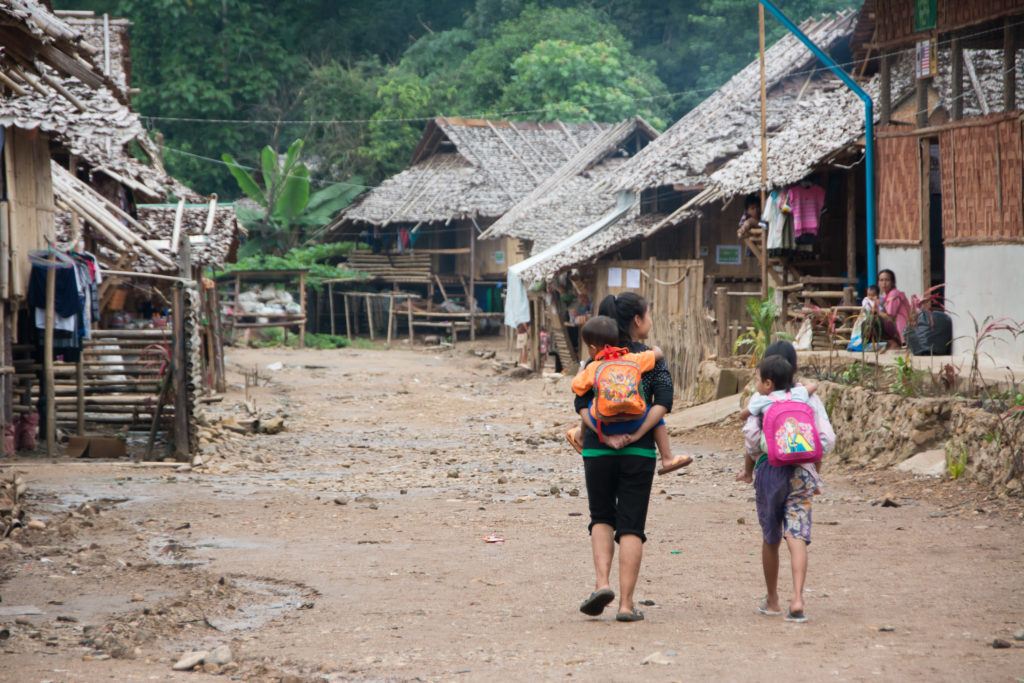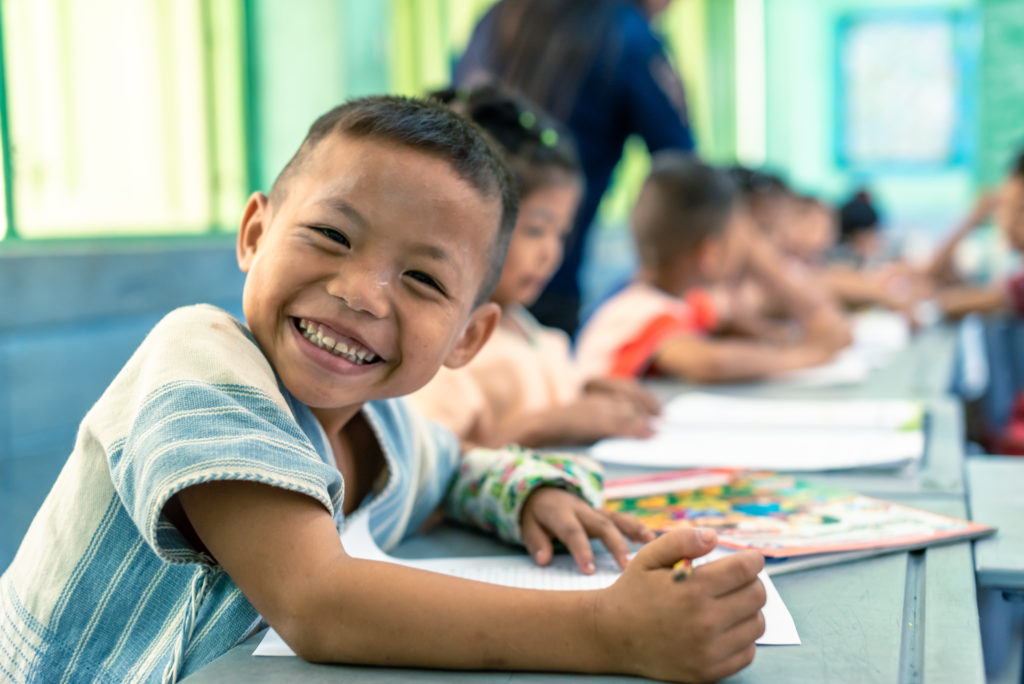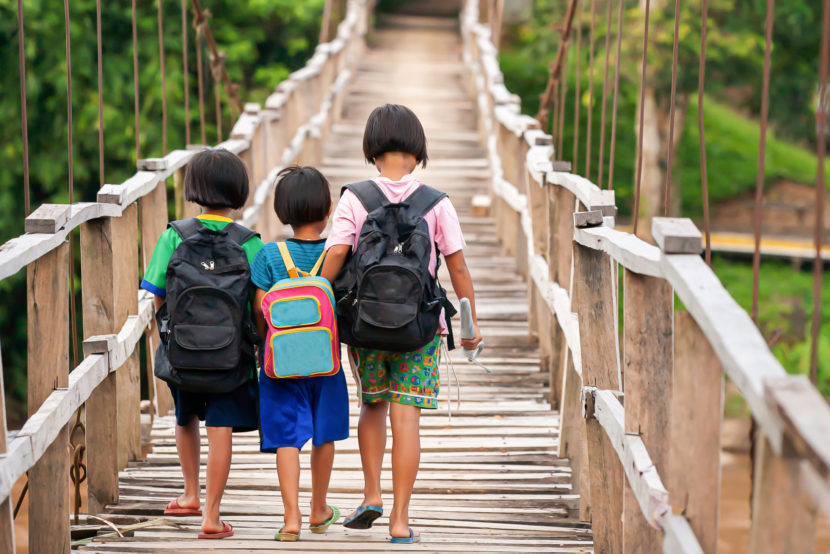Ongoing conflict in Myanmar has forced thousands of children to flee to Thailand, where they face significant barriers to accessing education. Despite legal provisions guaranteeing their right to schooling, many migrant children struggle with issues such as legal status, language barriers, and financial hardship. To ensure their right to education is upheld, greater collaboration between Thai authorities, educators, and humanitarian organizations is needed to create inclusive and sustainable learning opportunities.
Myanmar migrants in Thailand
Following a military coup in Myanmar on February 1, 2021, an increasing number of migrants continues to flee ongoing conflict, political instability, and economic hardship by seeking safety in Thailand (Amnesty International, 2025). As migrants flee Myanmar from conflict, they represent one of the largest groups of migrants in Thailand (IOM, 2024).
Since Thailand does not officially recognize refugees, many Myanmar migrants’ lack a defined status (Asylum Access, 2020). Many live in uncertainty, facing risks of deportation, exploitation, and have limited access to basic services. This is particularly the case for children of migrant parents who have a very limited access to education in Thailand.
Myanmar children’s right to education has no borders
Under international law, access to education is a fundamental human right. Both Thailand and Myanmar have ratified the United Nations Convention on the Rights of the Child (UNCRC), in 1992 and 1991 respectively, which protects the right of education (United Nations General Assembly, 1989). Thailand and Myanmar have therefore signed onto making primary education compulsory and free to all children regardless of background or nationality.
Thailand has further legislated that all individuals have equal rights and opportunities to receive basic education provided by the State for the duration of at least 12 years, starting at the age of 6 and ending at age 18 (Office of the National Education Commission Office, 1999).
Thai legislation also supports migrant education by ensuring any child within Thai jurisdiction “receive equal protection without discrimination based on race, skin color, language, religion, political or other opinions, national origin, ethnicity or social background, property, disability, birth, or other status of the child” (Khaosod, 2024). Further, 1999 and 2005 legislative policy specifically guarantees that all non-Thai children are entitled to enjoy free basic education in Thai public schools (The Nation Thailand, 2023).
While international and domestic law in Thailand guarantees access to education for migrant children from Myanmar, the reality in Thailand is quite different. Children from Myanmar living in Thailand struggle to access suitable education.
Barriers to education for Myanmar children in Thailand

It is estimated that at least 50,000 Myanmar migrant children are currently studying in Thailand (RFA, 2024). Many refugee and migrant children from Myanmar struggle to access education due to their family’s legal status, language barriers, and financial hardship (United Nations Network on Migration in Thailand, 2024).
While Thai public schools can serve Myanmar children, admission has been shown to be challenging as most children’s parents are undocumented migrants. The lack of Thai legal status makes it difficult for them to enrol in the public school system.
As the majority of migrant children are not proficient in Thai, language differences pose a significant hurdle for children accessing schools in Thailand. The language barrier makes it challenging for them to integrate into the Thai education system and comprehend the curriculum. The cost of schooling, including school fees, uniforms, and supplies, is an additional factor making education less accessible as the fees are often prohibitive for migrant families.
Lastly, Thailand has been faced with the challenge of overcrowded and underfunded public schools in the past 5 years (Cogan, 2022). This has led to scarce resources within schools and an inability to accommodate migrant children These challenges have led many Myanmar children to attend unregistered migrant learning centres (“MLCs”).
Migrant learning centres attempt to address the education gap
To address the lack of access to formal education in Thailand, many migrant children attend MLCs. These unregistered schools, which are funded by student fees and donations from charities, are often set up by migrant teachers and professionals from Myanmar. They operate outside the formal education system and are not recognized by Thai authorities (Swe, 2025).
Nearly 27% of migrant children in Thailand between the ages of 3 to 18 are educated in MLCs (UN, 2024). As of April 2024, it is reported that over 14,000 students enrolled in the 64 MLCs (UNESCO, 2024). Ongoing conflict in Myanmar has led to increasing enrolment pressures with a 40% rise in enrolment in Tak province in 2023–2024.
MLCs, which serve over 14,000 students, struggle with inadequate facilities and limited resources, leading to cutbacks in essential services like school lunches and teacher salaries (UNESCO, 2024). While addressing the gap and seeking to provide children with education, these schools face relentless threats of closure due to their undocumented status. During the past year, the threats of closure have become increasingly concrete.
In September 2024, the closure of an illegally operated migrant children’s learning centre in Tambon Bang Kung of Muang District led to the shutdown of all MLCs in the province (Mizzima, 2024). This resulted in over 2,000 migrant children in the area stopping their schooling midway through the school year (RFA, 2024).
During the past year, the closing of unregistered schools has affected over thousands of students. The parents of these children face a difficult choice: either continue working and leave their children home alone or stop working and lose their source of income to support their family.
Importance of education for migrant children from Myanmar
Education is critical for migrant children from Myanmar as it provides them with the tools to integrate into their new Thai community, fostering social inclusion and opportunities for a better future (United Nations Network on Migration in Thailand, 2024).
A lack of access to education significantly increases the vulnerability of migrant children to a range of severe risks, including crime, exploitation, labour abuse, and drug involvement (Benar News, 2024). Without education, these children often lack the skills and opportunities to secure legitimate employment, increasing the likelihood that they will turn to illegal activities as a means of survival.
Education is also a crucial aspect to help a child’s sense of identity (Arphattananon, 2022). The closure of MLCs has hindered the ability of migrant children to learn in their mother tongue and maintain cultural ties. This loss affects their cultural identity and sense of belonging. MLCs provides children with an environment to explore their cultural heritage, the expression of their values, and the development of a sense of pride in their identity.
New efforts are made to help migrant students
While operating unregistered schools violates Thai law, the country’s national laws mandate schooling for all children, regardless of nationality. As a result, following the closure of multiple MLCs, the Thai government reiterated that Myanmar migrant students can enrol in the province’s public schools (RFA, 2024).
Regional Thai governments have been working alongside various non-profit organisations to address migrant children’s right and need for access to education (UNESCO, 2024). For example, to respond to disruptions caused by the COVID-19 pandemic, collaborative programs alongside humanitarian partners have been developed to help 7,000 learners recover from learning loss using digital tools. Other partners have created projects to assist migrant parents with birth registration and school enrolment, addressing the administrative barriers faced by undocumented children trying to register in public school.
How to further improve access to education for migrants?
To best support Myanmar children with access to education in Thailand, Thai and Myanmar educators must work collaboratively with the government officials to ensure an inclusive and regulated education system is in place. Policy changes and an increase in teacher training and public funding are necessary to create a quality and inclusive education system for migrants. This system must best support the unique challenges faced by Myanmar migrants, while considering factors such as costs, linguistics, culture and rural accessibility.
Not only will this regulated schooling system require more funding, teacher training, and language support for migrant children, but further support and funding is needed in public Thai schools to accommodate the increasing number of Thai students seeking education.
Migrant children from Myanmar living in Thailand continue to face uncertainty, with limited opportunities and a lack of stable protection. The lack of access to education puts them in a highly vulnerable position to exploitation and hardship. It is crucial that the Thai government work collaboratively to ensure that migrant children from Myanmar have access to quality education in Thailand.
Humanium is dedicated to promoting and protecting children’s rights worldwide, with a strong focus on ensuring that every child, including migrant children, has access to quality education. As part of its mission, Humanium works to break down the barriers that prevent migrant children from receiving an education, advocating for their right to learn, grow, and thrive, regardless of their background or status.

Through partnerships, community-based initiatives, and policy advocacy, Humanium strives to create a more inclusive world where all children can enjoy their fundamental right to education. Join Humanium in supporting migrant children and their right to education. You can make a difference by donating, volunteering or becoming a member, helping us to continue our work in advancing children’s rights globally.
Written by Kathleen Tereposky
Bibliography:
Amnesty International. (2025). Human rights in Myanmar. Retrieved from Amnesty International at https://www.amnesty.org/en/location/asia-and-the-pacific/south-east-asia-and-the-pacific/myanmar/report-myanmar/, accessed on March 13, 2025.
Arphattananon, Thithimadee. (April 13, 2022). Education of Migrant Children from Myanmar in Thai Government Schools. Retrieved from Brill at https://brill.com/view/journals/mnya/24/3/article-p409_006.xml, accessed on March 13, 2025.
Asylum Access. (2020). Thailand. Retrieved from Asylum Access at https://asylumaccess.org/where-we-work/thailand/, accessed on March 13, 2025.
Cogan, Mark S. (March 30, 2022). Thai education beset by poor management, inequality, and high teacher debt. Retrieved from Issaan Record at https://theisaanrecord.co/2022/03/30/thai-education-beset-by-poor-management/, accessed on March 13, 2025.
IOM UN Migration. (April 2024). Overview of Myanmar Nationals in Thailand. Retrieved from IOM Thailand at overview-of-myanmar-nationals-in-thailand-october-24.pdf, accessed on March 19, 2025.
Khaosod English. (October 5, 2024). Illegal Myanmar School Uncovered in Thailand Coconut Plantation. Retrieved from Khaosod English at https://www.khaosodenglish.com/news/crimecourtscalamity/crime-crime/2024/10/05/illegal-myanmar-school-uncovered-in-thailand-coconut-plantation/, accessed on March 13, 2025.
Mizzima. (September 2024). Thai authorities clarify on closure of Burmese language learning centres in Thailand. Retrieved from Mizzima at https://eng.mizzima.com/2024/09/14/13951, accessed on March 13, 2025.
Office of the National Education Commission Office of the Prime Minister Kingdom of Thailand. (1999). National Education Act, B.E. 2542 at sec 10. Retrieved from the Office for Accreditation and Assessment of Educational Quality at https://www.onesqa.or.th/upload/download/file_697c80087cce7f0f83ce0e2a98205aa3.pdf, accessed on March 13, 2025.
RFA Burmese. (September 13, 2024). Thailand closes 6 schools for Myanmar migrant children in Surat Thani. Retrieved from BenarNews at https://www.benarnews.org/english/news/thai/schools-for-myanmar-children-close-in-surat-thani-09132024162609.html, accessed on March 13, 2025.
Swe, Moe Thaw Dar. (February 18, 2025). Learning the hard way: Migrant students grapple with high-stakes exams. Retrieved from Frontier Myanmar at https://www.frontiermyanmar.net/en/learning-the-hard-way-migrant-students-grapple-with-high-stakes-exams/, accessed on March 13, 2025.
The Nation Thailand. (January 20, 2023). Expanding access to education for children of migrants through learning centres. Retrieved from The Nation Thailand at https://www.nationthailand.com/blogs/thailand/general/40024182, accessed on March 13, 2025.
UNESCO. (June 17, 2024). UNESCO and partners provide emergency support for migrant children on the Thai-Myanmar border. Retrieved from United Nations at https://thailand.un.org/en/272856-unesco-and-partners-provide-emergency-support-migrant-children-thai-myanmar-border, accessed on March 13, 2025.
United Nations General Assembly. (November 20, 1989). Convention on the Rights of the Child. United Nations, Treaty Series, vol. 1577 at art 28. Retrieved from the United Nations Office of the High Commissioner for Human Rights at https://www.ohchr.org/en/instruments-mechanisms/instruments/convention-rights-child, accessed on March 13, 2025.
United Nations Network on Migration in Thailand. (2024). Thailand Migration Report. Retrieved from United Nations at thailand-migration-report-2024.pdf, accessed on March 13, 2025.


